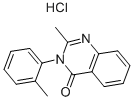Manufacturing Process
Anthranilic acid (1 part) is dissolved in acetic anhydride (2 parts) and the temperature raised progressively to 190° to 200°C while distillation takes place. The last traces of acetic acid are removed under vacuum and, after cooling to about 50° to 60°C, o-toluidine (1 part) is added in portions.
The temperature is then raised to 170° to 200°C when the excess water and o-toluidine is gradually distilled off, finally maintaining the temperature at 180° to 200°C for 2 hours. After cooling to about 100°C dilute hydrochloric acid (3 parts) is added and the mixture boiled and stirred. The solution is then neutralized with NaOH with stirring and the product which separates is recrystallized twice from alcohol after decolorizing with carbon. Yield: 70% of theoretical, LIP 114° to 115°C.
Safety Profile
Poison by ingestion,
intraperitoneal, and intravenous routes. An
experimental teratogen. Experimental
reproductive effects. Human systemic
effects. convulsions, dyspnea, pulse rate
increase. When heated to decomposition it
emits very toxic fumes of NOx and HCl.

